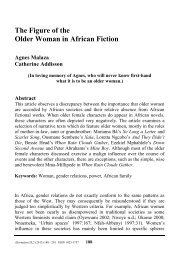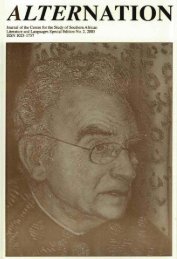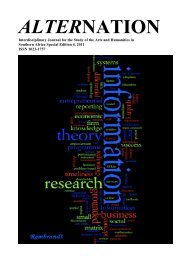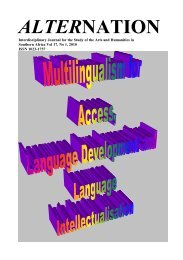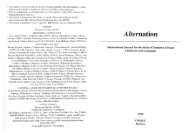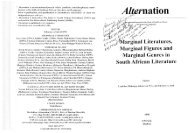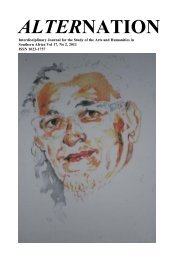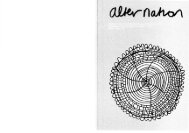Shane Moran - Alternation Journal
Shane Moran - Alternation Journal
Shane Moran - Alternation Journal
You also want an ePaper? Increase the reach of your titles
YUMPU automatically turns print PDFs into web optimized ePapers that Google loves.
lived modernity, and as complex and changeable. Her work also shows how 'the<br />
traditions of ~nodernity' are equally present as variously violent, exclusive and<br />
contlict~~al, but also intelwoven and interdependent in settler and chiefly ivorlds. At the<br />
same time, the nuanced interweaving of concepts makes problelnatic any easy or siinple<br />
dichotolnous conceptions of nationalism and political reconciliation.<br />
It is to these concerns of 'orality' and 'literacy' as the central organising<br />
concepts of the book that we wish to draw attention. Hofmeyr demonstrates that any<br />
interaction between orality and literacy (rather than using notions of explanatio~l<br />
between tradition and inodernity) needs to be sought in the details of each particular<br />
context and that the impact of literacy has no automatic consequence and callnot be<br />
predicted. As the case studies illuminate, the relationship between the spoken and the<br />
written was si~nultaneously co~nplexly interwoven in practice. and symbolically<br />
oppositional ir, tlie idea of orality (supposedly for tradition) and that of literacy<br />
(supposedly for tlie modern). She argues, though, that by the 1960s, historical tales had<br />
been tr-ansfor~ned under social and political pressures, but also by the combiiiation of<br />
oral and written historical accounts. in this context, and within the substantive changes<br />
between inale and female, and between historical and fictional stolytelling, the 'radical<br />
attrition oflneinory3 has currently taken place, alongside the alnplitude ofa previously<br />
marginalised and pail-onised craft ofstorytelling.<br />
Hofineyr thus provides a rich and nuanced account of the ways in ivhich<br />
words-spoken and written-have eloquence and power, but also of the ways they are<br />
socially co~istructed nod u~idelgo ti~resholds of change. decline, attrition and amplitude.<br />
She highlights the social conditions that control texts and audiences, but also sliows that<br />
attention to narrative structure is necessarily central to revealir~g the substance of ideas,<br />
diflring intellectual tiaditions (chiefly and settler) and the different and changing<br />
meanings ofthe past entailed in different dominant and subaltern, and modernist and<br />
nationalist accounts. Thus, for exan~ple, she is able to combine text and context in an<br />
erploiation in tlie production of local or 'indigenous' fonns of knowledge in the<br />
Mokopane or Valtyn chicftancy through looking at the oral historical narration dealing<br />
with the story of the cave of Gwala' (the siege of Makapansgat in i 554) She argues<br />
lliat lhese historici~l tales are draivn froni 'tile intellectui~l traditions undel-pinning<br />
cl~icilnncy' and are 'complex investigations into tlie meaning ofchiefsliip as a system<br />
of political authority and as a synibol of the entire social order' but also that the<br />
interaction bet\veeir oral and written accounts of the siege, and bctween chiefly anti<br />
settler accounts were by 110 means separate entities. They influenced each other in<br />
signiilcant ways so that the 'neat distinction between chiei1yJoral and settler/writteti is<br />
not possible' (F-iof'n~eyr- 1993: 14).<br />
l~ic~lcc. son?c\\~i~e~-c along the iilic. most \\;i.iltc~.r (settler) documciits lvcre<br />
bascd on oi.nl tcslimon)~ ... Equally. chielly vcl-sio1.r~ oftlic story apllropriatcd<br />
into thci~~selves fi-agrne~~ls ii.0111 flic ~v~-illeil accounts. In terms ol' thriiinlplicil<br />
fbl-nls of.intcrpretatioil. the two fsaililioiis also ir~lrrsecl in intrrcsting<br />
ivayx .. .<br />
Rut they hdve also changed 111 ~elatron to the changing 1-01 tunes of the chlefdorn, and In<br />
-<br />
I14<br />
relation to the change$111 the production, form and content ofthe storytelling. The stoty<br />
of the South African past, then, which draws on Hofineyr's approach to social h~stoly<br />
and subaltemity, is also much more mutual and lnterconnected than previously<br />
imagined, and the possibilities of a radical nationalist break in academic hlstoly<br />
productio~i is equally rendered as problematic if her work is held up as a model.<br />
Focused through the concepts of orality and literacy, then, Hofineyr's study<br />
has significant other implications. Not only does she suggest the need to attend to the<br />
orality of all written source^'^, and thus the entire documentary has that still ranks the<br />
written over the spoken in histoly, but also that to explore subaltern memory, identity<br />
and agency requires new cultural contexts and forms of analysis where language,<br />
translation and the 'evidence of experience' are engaged as material, social and<br />
narrative constructs. Thus, she says,<br />
while therc has been a lot of work that is based on oral hislorical inf'orination.<br />
this scholarship has tended to mine testimony ibr its 'facts' without paying<br />
~iiucli atlention to the forins of interpretation and intellectual traditions that<br />
inform these '[acts' (Hofnleyr 1993:9).<br />
A third very different work that examines the tensio~is of rule is that of Tirn<br />
Keegan's Colonial South Afiica u~zd fhc: Origins of the Racial Ordev (1 996). While<br />
Hofmeyr's work is situated in the meeting ground between text and context and<br />
between that of orality and literacy-and between social histoty and literary<br />
studies-and Van Onselen's between the structures and agency of 'histo~y frorn<br />
below', Keegan's study sets out explicitly to synthesise revisionist writing on<br />
nineteenth century South Africa in opposition to liberal historiography. Keegan's book<br />
Ilas a number of strengths and as the best syntheses are, is strikingly original: he traces<br />
the origins of modern SA racism and the racial state into the early period of integration<br />
of the Cape into the British Empire, re-assesses the relationships between Dutch slavery<br />
and British colonialism, tracks regional and i~nperial dimensiolls that have not been<br />
previously explored and compared, and reviews collventio~~al interpretatiol~s of such<br />
key lno~nertts as the Great Trek. Here, for example, Ile presents a strong argument,<br />
backed with evidence, to show the deep involvement of leading English-speaking<br />
settlers in produciilg what are conveiltio~~ally regarded as Afrikaner apologia for the<br />
Trek. This is breathtakingly daring! Moreover, the liberal tradition is revealed as not<br />
only being Janus-faced, but as deeply embedded within the violent construction of<br />
racialised and subaltern subjects.<br />
At the same titne, however, Keegan's work reflects some ofthe tensions oftliis<br />
kind of synthesis. It is largely a 'histoly from above'. It is about how the structures of<br />
dominalzce: of accumulation, thc colonial state and settler society were developed and<br />
how these structures of dominance necessarily and increasingly shaped the racialised<br />
'' F-lofn~eyr (1994; 1995) has engaged thcse issues in relation to oral liistory in Soutl~ Afi-ica in<br />
two important papers.<br />
115



